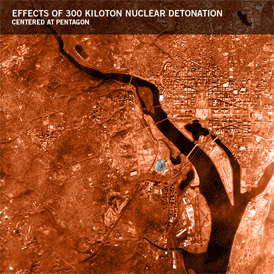|
Washington, D.C. - A nuclear weapon at the "small"
end of historic strategic arsenals that exploded over the
Pentagon would create a mass fire that would engulf the Washington,
D.C. area as far as Capitol Hill, Dupont Circle, and Alexandria.
According to a study published this month, the detonation
would not only unleash the well-known blast effects and hurricane
force winds that would crush the Pentagon and knock over nearby
buildings, but the bomb would also generate a "hurricane
of fire" that would destroy almost everything within
40 to 65 square miles. A firestorm is a predictable effect
of a nuclear detonation in an urban area, but since the 1940s,
U.S. war planners have disregarded the problem of mass fire
by focusing attention on blast effects only.
A new book
and the cover
story of the current issue of The Bulletin of the Atomic
Scientists by Stanford University scholar Lynn Eden
detail the scenario of the nuclear devastation of the Washington,
D.C. area. Exploring why the military disregarded nuclear
firestorms, Eden argues that the resulting underestimation
of the destructiveness of nuclear weapons made top officials
poorly informed about weapons effects and contributed to unnecessarily
high levels of nuclear forces. The organizational failure
to understand weapons effects, Eden argues, could have produced
a nuclear catastrophe; similar organizational failures produced
the Titanic disaster and the poor fireproofing of the World
Trade Center.
|
 |
